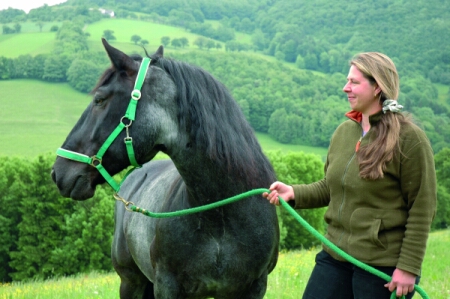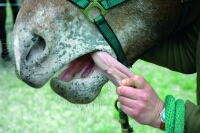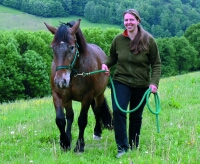From the horse practice of the Austrian Federal Champion Elfi Köttner
The realisation that reduced performance, serious illnesses and their related symptoms are only the end of a frequently long series of disorders has grown over the years in veterinary medicine too. And this has led to the recognition that there is little sense in just treating the symptoms at the end of this series. Particularly in the treatment of horses, more and more integrated therapy methods are being applied; the basis is the awareness that healing can only take place where the causes of a disorder are to be found.
But despite sophisticated diagnostic methods, it is precisely in this research that horse owners, therapists and veterinary surgeons often come up against their limits. Instrumental biocommunication here apparently represents a possibility of obtaining important patient information. With the aid of modern systems, not only can findings be secured, but also causal connections can often be established. The animal’s owner often confirms these indications later. Because particular past events were missing or even unknown to the horse owner, they could not be taken into account in the anamnesis. In some cases however, the analysis offers completely new points of departure that were not detected using the usual diagnostic methods. Elfrieda Köttner too found this out when she tried to find the reason for the recurring lameness of her mare Zedes.
Elfrieda Köttner and Rudi Blamauer manage the Noric horse stud in Stössing, Lower Austria, where she is responsible for training Noric horses that are largely bred there. Her chief passion is Western riding, and meanwhile Elfrieda Köttner, with her heavy Noric horses, has advanced from an exotic outsider to a figure to be reckoned with in the Western scene. With her Noric mare Zedes, she achieved her greatest tournament successes: she has claimed victories and placings in the heavy Reining class and even a victory at the Austrian Federal Championships.
As Zedes again and again became lame and the vets were ultimately unable to find the cause, Elfi Köttner, who herself studied medicine, began to search for alternatives. A member of the riding school drew her attention to instrumental biocommunication. An analysis provided the decisive indication: a fissure in the kneecap was apparently the reason for the mare’s considerable restrictions of movement. Elfi Köttner saw that it was related to a wound that Zedes had suffered in the field as a 2-year-old. Although the knee wound had been treated, the fissure had gone unnoticed. The analysis also pointed to a vitamin B deficiency, a brain parasite, and a latent herpes infection.
Another example from Elfi Köttner’s stable is Franka, who caused great concern to her owner with persistent exhaustion and feebleness. When its teeth were changing, the young mare had suffered an injury to the tongue.
The QUANTEC® analysis revealed not only the connection to this wound but also indicated an incipient intestinal cancer, which was apparently originally responsible for the mare’s poor general condition. Furthermore, a deliberate and careful selection and querying of databases showed that Franka had been ridden with a badly fitting saddle and that the fourth and fifth cervical vertebrae were tilted to the right – a diagnosis that the osteopath later confirmed and corrected. Following radionic treatment with QUANTEC®, the tongue wound healed fast, and during later checks, there was no further sign of cancer. The horse appeared ever more fresh and was obviously enjoying its work.
“The consistencies of the findings impressed me very deeply,” says Elfi Köttner, but a certain scepticism remained in view of the inexplicable procedure. “It was certainly therefore a personal test to convince me of the reliability of QUANTEC® when I sent hairs from Bruni’s tail for analysis. I wanted to find out if the system really could detect events or illnesses from the distant past, which would be an enormous benefit for the treatment of our horses.”
Bruni was four years old, was considered to be disturbed and difficult to handle, and had substantial psychic problems when Elfi Köttner rescued the horse from the slaughterhouse. With patience and skilled horsemanship, she was gradually able to gain the horse’s confidence. But at five, the Noric horse had a serious accident, falling 12 meters into a well where it was stuck fast for hours before finally being pulled out by a crane in a spectacular rescue action. Amazingly, this accident apparently had no major physical consequences. Two years later, however, the horse no longer seemed to be completely fit, suffered from lack of appetite, its physical development was not optimal, lost its rhythm during riding, and attracted attention by its sudden outbursts of temper.
Elfi Köttner sent Bruni’s tail hairs for a QUANTEC® analysis and received a comprehensive report: the databases queried – among other things about such subjects as homeopathy, Bach flowers, osteopathy, Schüssler salts and orthomolecular medicine – produced a “healing sheet” two years after the accident with the following indications:
In the analysis, QUANTEC® determines the remedies for treating the causes of the underlying problem. These include homeopathic medicaments, nosodes, Bach flowers and minerals. With the help of these remedies, the therapist can draw his conclusions about a diagnosis. In Bruni’s case, for example, the Bach flowers – cherry plum and holly – pointed to the horse’s tense emotional state. According to the Bach flower therapy, horses that need cherry plum are suffering from great inner tension. Although they can be led and ridden around, they have no peace and composure. The cause is usually traumatic experiences in the horse’s past. The homeopathic medicament Sanukehl Salm, which is used to treat the intestine, supplied the connection to the worm attack.
But QUANTEC®
does not only determine the necessary remedies, but also the times and
duration of the radiation required. The transmission of these healing
vibrations to the patient takes place, as with the analysis of the
surrogate, via the white noise diode at the heart of the equipment (see
Comed 08/2006).
Bruni’s treatment took place in two two-month radiation with QUANTEC®, and according to Elfi Köttner, even the blockade in the lumbar spine disappeared without any additional osteopathic treatment. Bruni also received Sanukehl Salm in the form of drops to purify the intestine; deliberate food supplements made up for the vitamin and mineral deficits. This comprehensive course of treatment restored Bruni to a good physical condition; the horse has also regained its peace and composure and is now a reliable partner for its rider.
Conclusion
Regardless of the current scientific status, practical examples and empiric results are supplying therapists with a basis for assessing the possibilities and limits of instrumental biocommunication in the veterinary practice.
QUANTEC® provides optimal conditions for integrated therapy on the basis of the versatile organisational options of databases.
Sabine Heüveldop
Publikation & Gestaltung
Mühlenbrok 11
48249 Dülmen
Tel. 0 25 94/8 46 34
Fax: 0 25 94/78 79 60
www.sabine-heueveldop.de
info@sabine-heueveldop.de
by Sabine Heüveldop
The realisation that reduced performance, serious illnesses and their related symptoms are only the end of a frequently long series of disorders has grown over the years in veterinary medicine too. And this has led to the recognition that there is little sense in just treating the symptoms at the end of this series. Particularly in the treatment of horses, more and more integrated therapy methods are being applied; the basis is the awareness that healing can only take place where the causes of a disorder are to be found.
 |
|
The positive treatment success has convinced Elfi Köttner. In the
meantime,
she has become a QUANTEC® user herself. (Photo: Sabine Heüveldop) |
But despite sophisticated diagnostic methods, it is precisely in this research that horse owners, therapists and veterinary surgeons often come up against their limits. Instrumental biocommunication here apparently represents a possibility of obtaining important patient information. With the aid of modern systems, not only can findings be secured, but also causal connections can often be established. The animal’s owner often confirms these indications later. Because particular past events were missing or even unknown to the horse owner, they could not be taken into account in the anamnesis. In some cases however, the analysis offers completely new points of departure that were not detected using the usual diagnostic methods. Elfrieda Köttner too found this out when she tried to find the reason for the recurring lameness of her mare Zedes.
Elfrieda Köttner and Rudi Blamauer manage the Noric horse stud in Stössing, Lower Austria, where she is responsible for training Noric horses that are largely bred there. Her chief passion is Western riding, and meanwhile Elfrieda Köttner, with her heavy Noric horses, has advanced from an exotic outsider to a figure to be reckoned with in the Western scene. With her Noric mare Zedes, she achieved her greatest tournament successes: she has claimed victories and placings in the heavy Reining class and even a victory at the Austrian Federal Championships.
As Zedes again and again became lame and the vets were ultimately unable to find the cause, Elfi Köttner, who herself studied medicine, began to search for alternatives. A member of the riding school drew her attention to instrumental biocommunication. An analysis provided the decisive indication: a fissure in the kneecap was apparently the reason for the mare’s considerable restrictions of movement. Elfi Köttner saw that it was related to a wound that Zedes had suffered in the field as a 2-year-old. Although the knee wound had been treated, the fissure had gone unnoticed. The analysis also pointed to a vitamin B deficiency, a brain parasite, and a latent herpes infection.
 |
|
| Completely healed: only a scar under the tongue remains of Franka’s wound. (Photo: Sabine Heüveldop) |
Another example from Elfi Köttner’s stable is Franka, who caused great concern to her owner with persistent exhaustion and feebleness. When its teeth were changing, the young mare had suffered an injury to the tongue.
The QUANTEC® analysis revealed not only the connection to this wound but also indicated an incipient intestinal cancer, which was apparently originally responsible for the mare’s poor general condition. Furthermore, a deliberate and careful selection and querying of databases showed that Franka had been ridden with a badly fitting saddle and that the fourth and fifth cervical vertebrae were tilted to the right – a diagnosis that the osteopath later confirmed and corrected. Following radionic treatment with QUANTEC®, the tongue wound healed fast, and during later checks, there was no further sign of cancer. The horse appeared ever more fresh and was obviously enjoying its work.
“The consistencies of the findings impressed me very deeply,” says Elfi Köttner, but a certain scepticism remained in view of the inexplicable procedure. “It was certainly therefore a personal test to convince me of the reliability of QUANTEC® when I sent hairs from Bruni’s tail for analysis. I wanted to find out if the system really could detect events or illnesses from the distant past, which would be an enormous benefit for the treatment of our horses.”
Bruni was four years old, was considered to be disturbed and difficult to handle, and had substantial psychic problems when Elfi Köttner rescued the horse from the slaughterhouse. With patience and skilled horsemanship, she was gradually able to gain the horse’s confidence. But at five, the Noric horse had a serious accident, falling 12 meters into a well where it was stuck fast for hours before finally being pulled out by a crane in a spectacular rescue action. Amazingly, this accident apparently had no major physical consequences. Two years later, however, the horse no longer seemed to be completely fit, suffered from lack of appetite, its physical development was not optimal, lost its rhythm during riding, and attracted attention by its sudden outbursts of temper.
Elfi Köttner sent Bruni’s tail hairs for a QUANTEC® analysis and received a comprehensive report: the databases queried – among other things about such subjects as homeopathy, Bach flowers, osteopathy, Schüssler salts and orthomolecular medicine – produced a “healing sheet” two years after the accident with the following indications:
• Impactions in the lumbar spine
• Inflammation of the oral cavity
• Water agglomerations in the inner ear
• Worm attack
• Mineral and vitamin deficiency and in the psychic area
• Fear of death
• Hate and rage
These indications, of both physical and mental disorders, were clearly
closely connected to the traumatic event of the accident. The
displacements in the lumbar spine were plausible consequences of the
accident, in which the hose had fallen into the well hindquarters
first. The water agglomerations in the inner ear could be traced back
to the physical efforts undertaken by the horse in the narrow hole.• Inflammation of the oral cavity
• Water agglomerations in the inner ear
• Worm attack
• Mineral and vitamin deficiency and in the psychic area
• Fear of death
• Hate and rage
In the analysis, QUANTEC® determines the remedies for treating the causes of the underlying problem. These include homeopathic medicaments, nosodes, Bach flowers and minerals. With the help of these remedies, the therapist can draw his conclusions about a diagnosis. In Bruni’s case, for example, the Bach flowers – cherry plum and holly – pointed to the horse’s tense emotional state. According to the Bach flower therapy, horses that need cherry plum are suffering from great inner tension. Although they can be led and ridden around, they have no peace and composure. The cause is usually traumatic experiences in the horse’s past. The homeopathic medicament Sanukehl Salm, which is used to treat the intestine, supplied the connection to the worm attack.
 |
|
| Fig. 3: Having fun at work again: Elfi Köttner with her Noric mare Franka, seen here in an excellent state of health. (Photo: Sabine Heüveldop) |
Bruni’s treatment took place in two two-month radiation with QUANTEC®, and according to Elfi Köttner, even the blockade in the lumbar spine disappeared without any additional osteopathic treatment. Bruni also received Sanukehl Salm in the form of drops to purify the intestine; deliberate food supplements made up for the vitamin and mineral deficits. This comprehensive course of treatment restored Bruni to a good physical condition; the horse has also regained its peace and composure and is now a reliable partner for its rider.
Conclusion
Regardless of the current scientific status, practical examples and empiric results are supplying therapists with a basis for assessing the possibilities and limits of instrumental biocommunication in the veterinary practice.
QUANTEC® provides optimal conditions for integrated therapy on the basis of the versatile organisational options of databases.
Sabine Heüveldop
Publikation & Gestaltung
Mühlenbrok 11
48249 Dülmen
Tel. 0 25 94/8 46 34
Fax: 0 25 94/78 79 60
www.sabine-heueveldop.de
info@sabine-heueveldop.de




